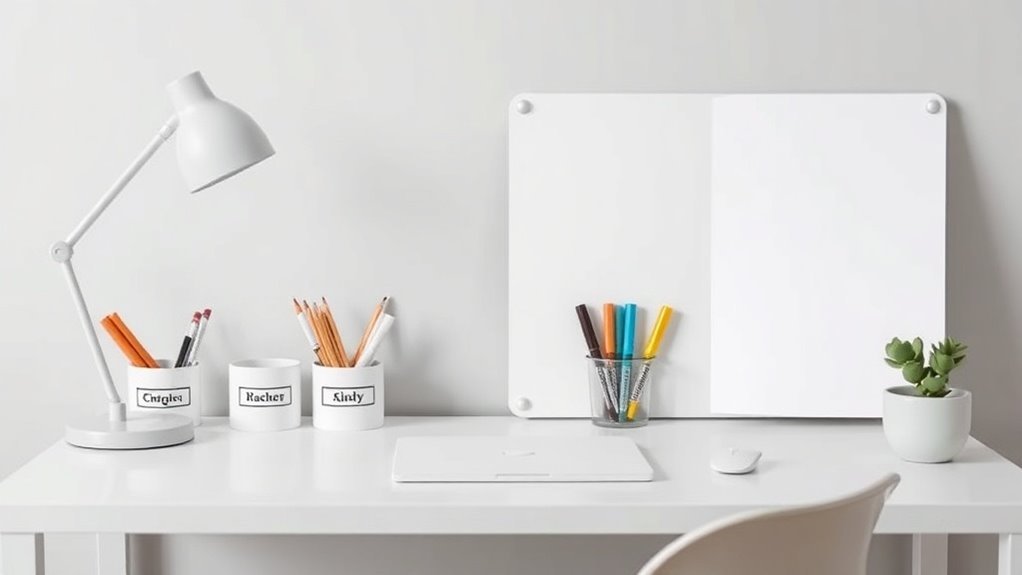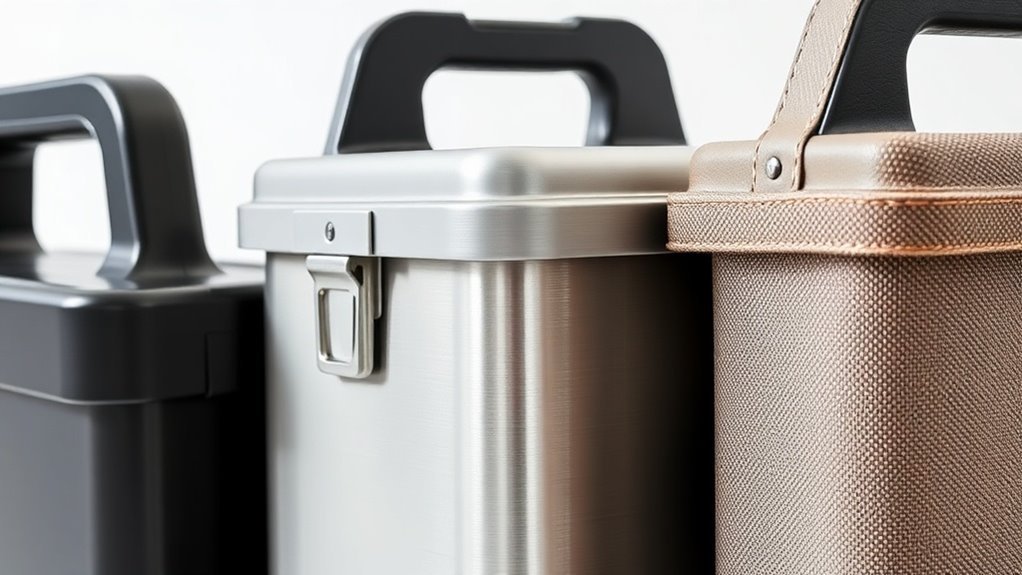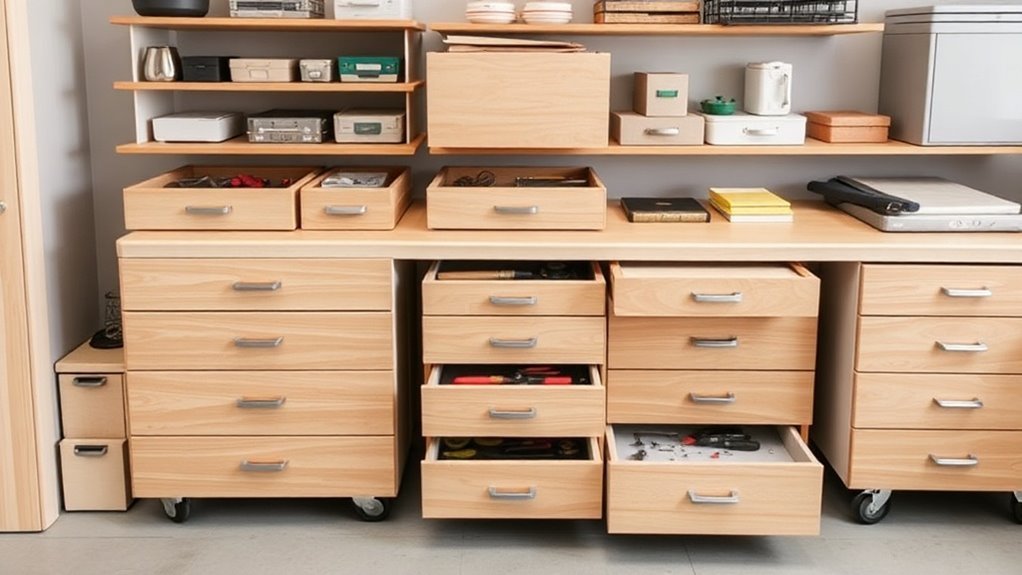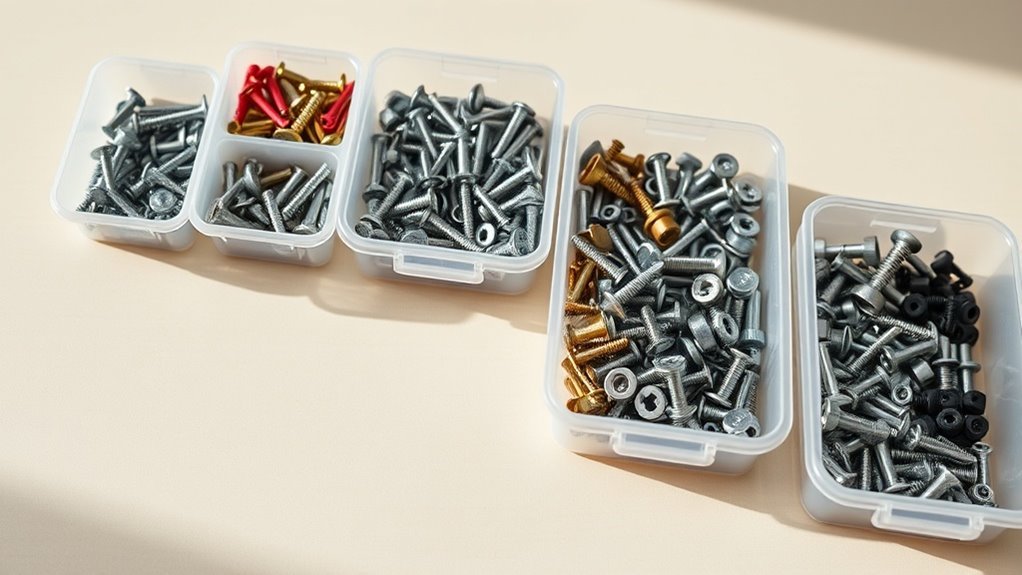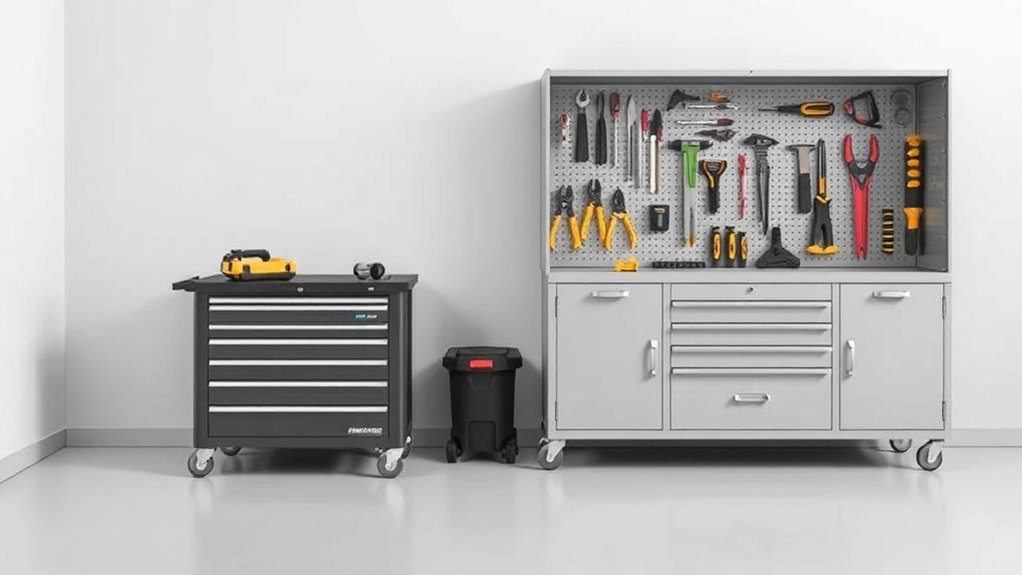How Climate Affects Tool Storage Needs
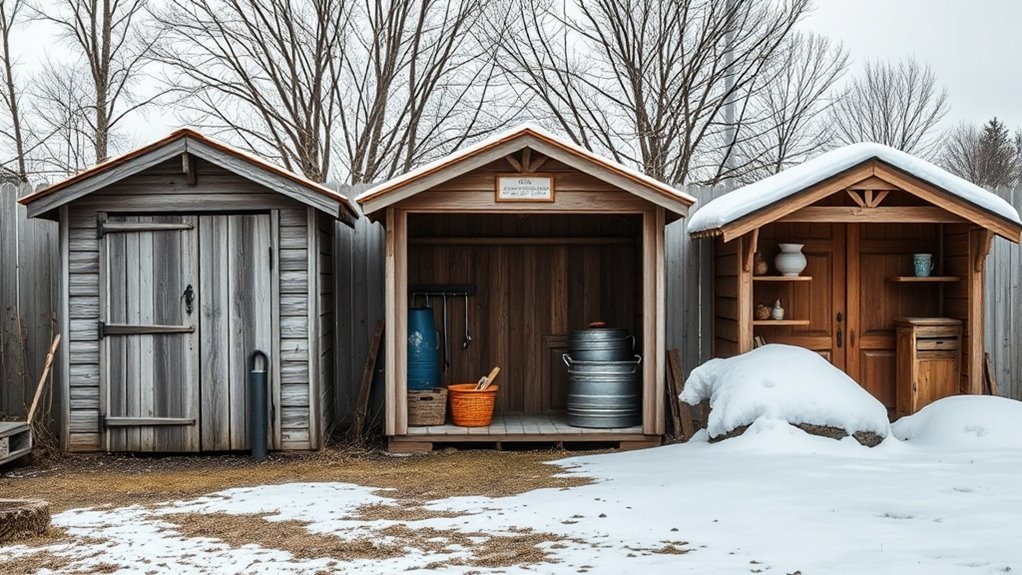
Climate has a huge impact on your tool storage needs. High humidity can cause rust and corrosion, so you’ll want to use airtight containers. In extreme cold, insulation is key to protect against freezing. On hot days, well-ventilated areas help prevent overheating. Moisture from rain can damage both metal and wooden tools. It’s vital to take these factors into account to avoid damage, and there are even more strategies you can use to safeguard your tools effectively.
Key Takeaways
- High humidity requires airtight containers and desiccants to prevent rust and corrosion on metal tools.
- In cold climates, insulated storage and heating elements are essential to prevent freezing or brittleness of tools.
- Hot environments need well-ventilated storage to avoid overheating, along with insulated containers for sensitive tools.
- Rain exposure necessitates regular inspections and elevated storage to prevent water damage and rust formation.
- Dry climates benefit from breathable materials to minimize dust accumulation while ensuring tools are protected from moisture.
The Impact of Humidity on Tool Storage
While you mightn’t think about humidity when storing your tools, it can greatly affect their longevity and performance. High humidity levels can lead to rust and corrosion, especially for metal tools.
If your workspace is damp, moisture can seep into cracks and crevices, damaging not only your tools but also any stored equipment nearby. To mitigate this, consider using a dehumidifier or desiccants to absorb excess moisture. Additionally, applying protective coatings can provide an extra layer of defense against rust.
Keeping your tools clean and dry is essential, so regularly wipe them down to remove moisture. You might also want to store them in a climate-controlled environment or sealed containers to guarantee they stay protected.
Protecting Tools From Extreme Cold
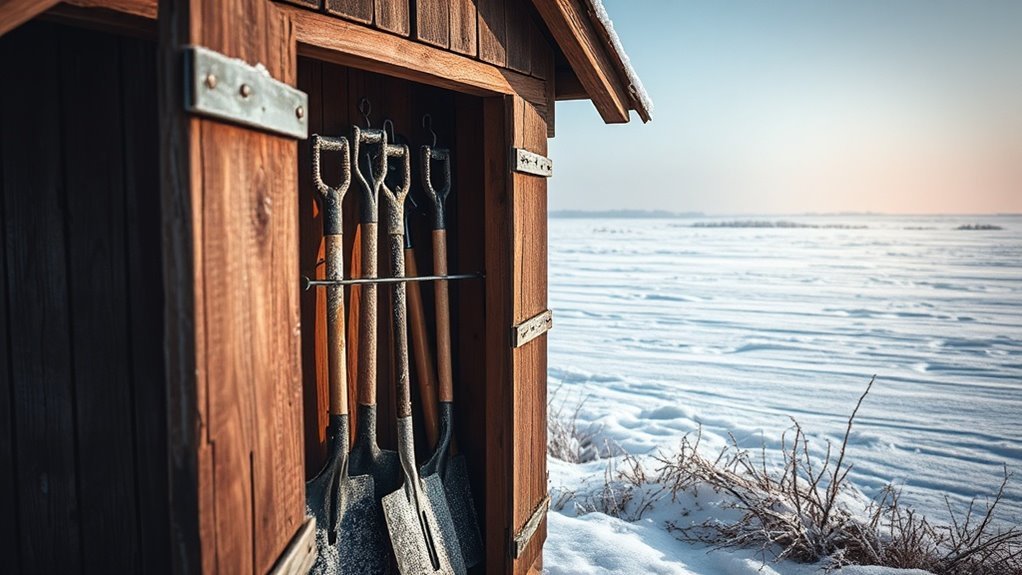
Cold temperatures can be just as damaging to your tools as high humidity. Extreme cold can lead to freezing, brittle materials, and can affect performance. To protect your tools, consider the following strategies:
| Protection Method | Benefits | Tips |
|---|---|---|
| Insulation | Maintains temperature | Use insulated storage boxes |
| Heating Elements | Prevents freezing | Install a space heater |
| Covered Storage | Shields from cold winds | Use tarps or covers |
Managing Tool Storage in Hot Environments
As temperatures soar, managing tool storage becomes crucial to prevent damage and guarantee your tools remain in top condition.
First, make certain your storage area is well-ventilated to circulate air and reduce overheating. Consider using insulated containers for sensitive tools, as they can help shield them from extreme heat. When possible, store tools indoors or in shaded areas to minimize sun exposure.
Regularly check for signs of wear or deterioration, especially on rubber or plastic components. If your tools are metal, applying a light protective oil can help prevent rust. Additionally, implementing proper storage containers can safeguard tools from heat-related damage.
Finally, be mindful of the heat’s effects on materials like wood, which can warp or crack. By taking these steps, you’ll keep your tools functional and ready for use when you need them.
The Effects of Rain and Moisture on Tools
Rain and moisture can have a significant impact on the longevity and performance of your tools.
If you’re not careful, they can lead to rust, corrosion, and decreased functionality.
Here are three key effects to regard:
- Rust Formation: Metal tools are particularly prone to rust when exposed to moisture, which can weaken their structure.
- Electrical Damage: If you own power tools, moisture may cause internal electrical issues, leading to malfunctions or irreparable damage.
- Grip Erosion: Wooden handles can absorb moisture, making them weak and slippery, which compromises safety and control.
Additionally, regular inspections of your tools after exposure to moisture can help identify early signs of damage before they worsen.
Best Practices for Tool Storage by Climate Type
While climate can greatly influence how you store your tools, understanding the specific conditions of your environment will help you protect your investments effectively.
In humid areas, choose airtight containers or cabinets to thwart rust and corrosion. For dry climates, consider using breathable materials to prevent dust from accumulating on your tools.
If you live in a region with extreme temperatures, insulation or climate-controlled storage spaces can help maintain ideal conditions. Always keep tools off the ground to avoid water damage and use pegboards or wall-mounted storage in garages to maximize ventilation.
In cold climates, make sure tools are dry before storing them to prevent freezing and thawing issues.
Choosing the Right Materials for Tool Storage Solutions
When it comes to tool storage, selecting the right materials is essential for their longevity and performance. You’ll want weather-resistant options that can withstand the elements, alongside temperature-adjusted storage solutions to prevent damage. Don’t forget about humidity control to keep your tools in ideal condition. Additionally, considering the accessibility and organization of your storage solution can significantly enhance efficiency in your workspace.
Weather-Resistant Materials
Choosing the right materials for your tool storage solutions is essential, especially if you want to protect your investments from the elements. Weather-resistant materials can help guarantee your tools remain in top shape, regardless of rain, humidity, or temperature fluctuations.
Here are three materials to take into account:
- High-density polyethylene (HDPE): This durable plastic is resistant to moisture, chemicals, and UV rays, making it a perfect option for outdoor storage.
- Stainless steel: Corrosion-resistant and strong, stainless steel boxes provide excellent protection against rust and harsh weather.
- Galvanized metal: Coated with a protective layer, galvanized metal resists corrosion and can withstand varying climates, ideal for both indoor and outdoor settings.
Select the best options for prolonged tool life and successful projects!
Temperature-Adjusted Storage Options
Since temperature extremes can impact the performance and longevity of your tools, it’s vital to take into account storage options that accommodate changing conditions.
For colder climates, consider insulated storage units to prevent metal parts from becoming brittle or rusting. In hot areas, opting for heat-resistant materials like polyethylene can prevent warping and degradation of tool components.
Using metal shelving can provide additional protection, but verify it’s coated to resist temperature fluctuations. If you’re using plastic bins, make certain they’re made from high-quality, durable materials that won’t warp under heat.
Always remember to keep the storage area well-ventilated, allowing natural air circulation. This way, your tools remain in top condition, ready for use whenever you need them.
Humidity Control Solutions
While managing temperature is important, humidity also plays a significant role in tool preservation. High humidity can lead to rust and corrosion, damaging your tools over time.
It’s essential to choose the right materials for your storage solutions to combat these issues effectively. Here are three options to evaluate:
- Humidity-Controlled Cabinets: Invest in cabinets with built-in dehumidifiers to maintain ideal conditions.
- Silica Gel Packs: Place these in your toolboxes or storage areas to absorb excess moisture.
- Rust-Resistant Coatings: Use tools coated with materials that prevent moisture from causing damage.
Questions
How Often Should I Check My Tool Storage Conditions?
You should check your tool storage conditions at least once a month. Changes in temperature and humidity can sneak up on you, so regular checks help guarantee your tools stay in peak condition. Don’t skip this step!
Can I Use Household Items for Tool Storage?
Why not repurpose household items for tool storage? You can use containers like jars, bins, or even shoe organizers! It’s creative, cost-effective, and helps keep your tools organized while using what you already have.
What Are Signs of Tool Damage From Climate Exposure?
You’ll notice rust on metal, warping or cracking in wood, and discoloration on plastics. If tools feel sticky or have corrosion, they’re likely suffering from climate exposure. Regular checks can help prevent further damage.
How Can I Organize Tools for Easy Access in Different Climates?
When it comes to organizing tools for easy access, don’t sweat it—label drawers, use vertical storage, and keep frequently used items within reach. Adjust your setup based on climate, ensuring protection from moisture or extreme temperatures.
Are There Eco-Friendly Options for Tool Storage Solutions?
You can opt for recycled plastic storage bins, bamboo racks, or biodegradable materials. These eco-friendly options not only help organize your tools but also contribute to reducing your environmental footprint. You’ll make a positive impact!
Conclusion
In the dance of climate and tools, understanding each step is key. When humidity whispers, keep your treasures dry; in the chill of winter, don’t let cold steal your edge. As summer sizzles, find shade to shield your gear, and when rains pour, a watertight haven is your best friend. By choosing the right materials and solutions, you’ll guarantee your tools stay sharp and ready, no matter what Mother Nature throws your way.

